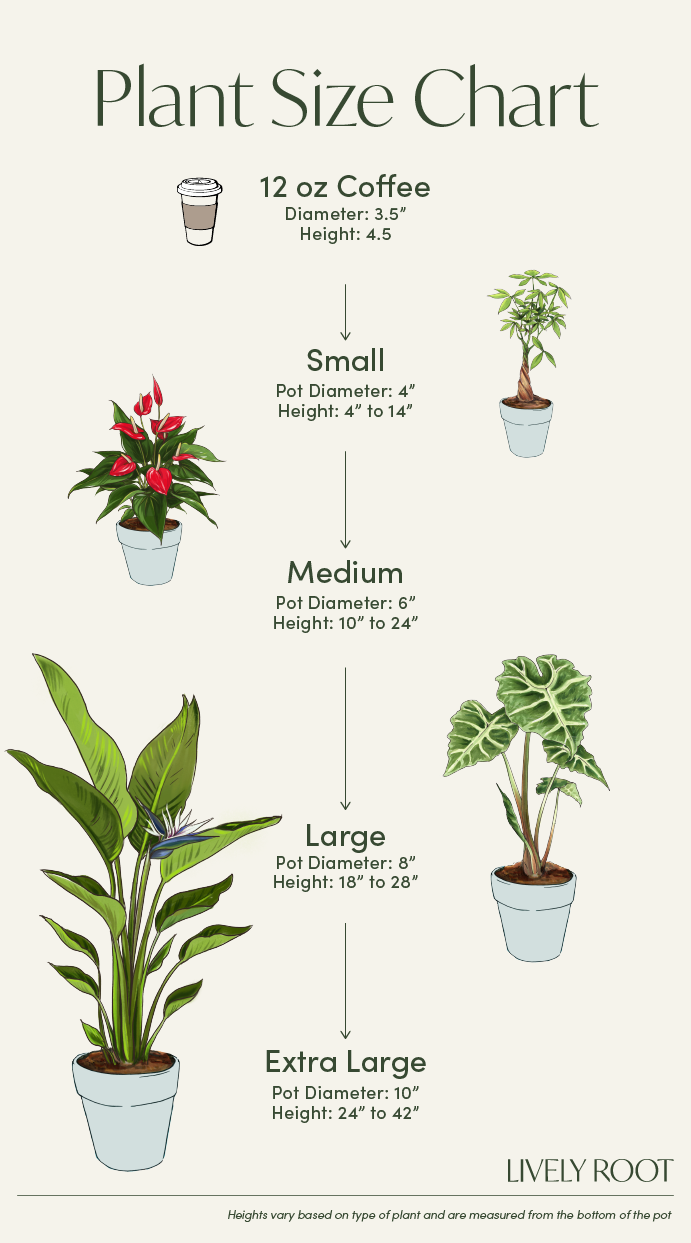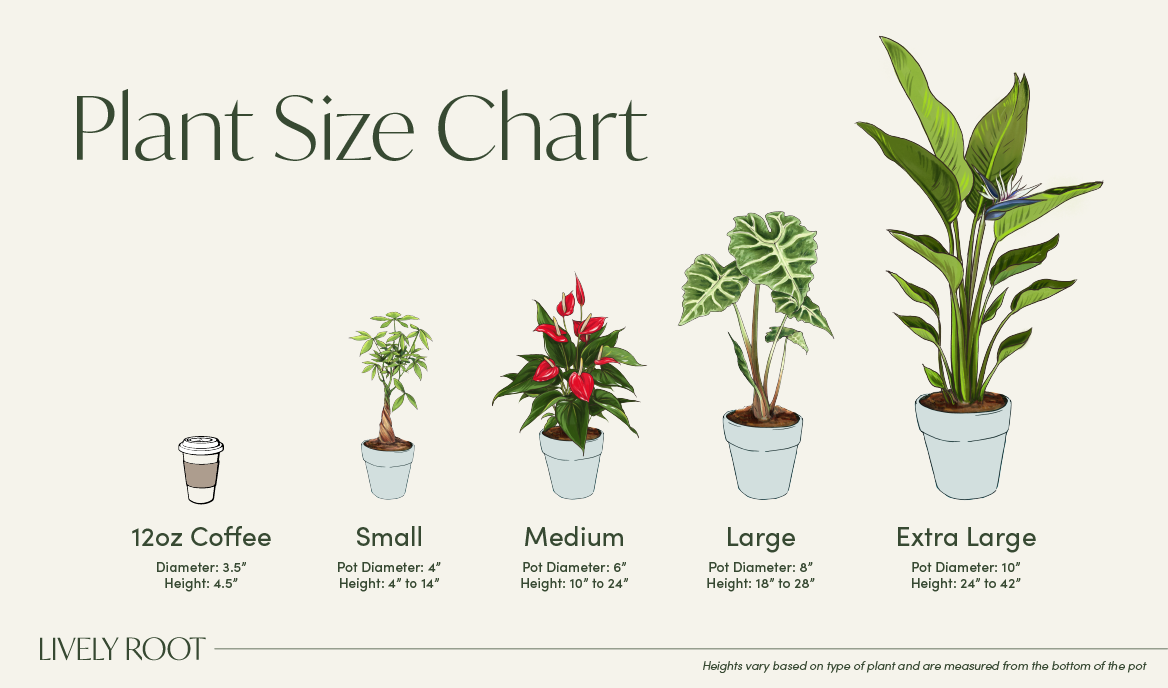

The Dieffenbachia Camille's oval leaves feature green edges that fade to white in the center. Sometimes considered more of a shrub than anything, this evergreen houseplant is extremely popular because, well, they are really easy to grow. Be sure to keep them out of prolonged direct sunlight and to avoid overly wet soil.
Dieffenbachia Camille Care Guide & Presentation

Enjoys medium to high indirect light.
Water when received, allow the soil to dry out between waterings.
Enjoys humidity. Spritz occasionally.
Keep this plant out of cold drafts near open windows or doors.
Outside: Keep them in full shade on a patio out of direct sunlight to prevent leaf burn.
Apply a liquid fertilizer especially formulated for indoor plants. Apply during the spring, summer and fall season. Let them rest during the winter.
When receiving the Dieffenbachia, do not repot immediately but wait at least 6-12 months or if the roots are beginning to get crowded and growing through the drainage holes.
Repot in the spring, using a 2 inches bigger pot to keep the roots drier. (Too big of a pot could cause the soil to dry slower, which is not helpful.)
Place a piece of screening at the bottom of the container over the drainage hole to secure the soil and allow them to drain. Use a well-draining indoor potting mix with perlite to help with drainage.
Water your plant in the old pot before transferring over and let them sit an hour.
Add soil to the bottom to elevate the root ball. Lift the plant and release the roots against the existing planter. Use a clean knife or garden trowel to wedge between the pot and the soil to loosen.
Inspect the root ball. Notice if there are any dead or rotting roots and trim off with sterile pruners. If the plant is rootbound, cut through the roots to alleviate continued encircling.
Ensure the plant is sitting about 1 inch below the edge of the pot to avoid water spillage. Add more soil and backfill around the sides by tamping down. Fill up to the soil line but not over.
Water thoroughly, leaving the soil damp but not soggy. If settling occurs, add more soil.
Water well to dampen the soil and let it drain.
To shape your Umbrella tree, use pruners and cut right above the leaves. From here, the stem will fork and create two branches and produce more growth. Remove any dead, damaged, or diseased leaves. Remove dropped leaves on the soil surface and replenish the soil if needed.
To keep your Dieffenbachia from growing leggy, prune each quarter. Remove top growth to encourage your plant to stay more compact and bushy. If your Dieffenbachia has become too leggy, then cut back on the stalk to where you want them to begin to put on new growth and stay more compact. Do not remove more than one-third of the entire plant at one time, or this will cause too much stress and hinder their health. Look for any pests or diseases. Remove any debris from the soil and replenish if necessary.
To propagate this plant during the growing season, take a stem cutting in the early spring. Use a knife or sharp pruners, cut below a node where there are at least three leaves. Find a place in the plant where there are still stalks on either side with leaves so they will have a chance to generate new leaves. Place the stem in a glass jar and fill with filtered water and watch the roots grow! Replace and freshen the water each week. After the roots are several months old, add to moistened potting soil, continue to water, and give them the bright, indirect lighting requirements.
Soil propagation includes dipping the cutting in hormone stimulator and placing in prepared rich, well-draining, moist (but not soggy) soil with plenty of aeration. Keep the soil moist for approximately four weeks until roots begin to grow. You can tug slightly on the stalk to see if roots are grabbing and holding after this time. Provide them bright, indirect light to acquire the photosynthesis for growth to occur.
Remove the plant from the pot. Hold the base and turn upside down with your palm securely holding the plant. Gingerly pull the pot off the root base. Remove the soil around the plant so the individual stalks can be separated. Use a chopstick to help wedge between the stalks and separate. Carefully separate all the roots to their individual stalks. Repot each in new well-draining aerated soil. Use a smaller pot for each stalk carefully not using a bigger pot may be harder to regulate their watering needs. Fill with soil, leaving an inch below the soil edge to eliminate water spillage. Water and let drain well.
Dieffenbachia Camille: Overview
The Dieffenbachia Camille (Dieffenbachia maculata ‘Camille’) is a lush plant with broad, oval-shaped leaves that are creamy white in the center and vivid green at the edges. It is also commonly known as Dumb Cane. The Dieffenbachia Camille belongs to the Araceae family, which includes many popular houseplants, like the Peace Lily or the Flamingo Flower.
This beautiful indoor plant is native to North and South America and parts of the West Indies. Being a tropical plant, Camille Dieffenbachia thrives in warm temperatures and medium humidity, and it can be grown outside in USDA hardiness zones 10-12. As an indoor plant, the Dieffenbachia Camille reaches about 6 ft. in height. Dieffenbachia is easy to grow and adaptable, preferring medium to bright indirect light. Unfortunately, the Camille plant is toxic to pets and should always be kept out of their reach. Dieffenbachia is believed to bring luck and good fortune and symbolizes flexibility, strength, and growth.
Other Dieffenbachia varieties to elevate your living space include the speckled Dieffenbachia Tropic Snow and the elongated, elegant Dieffenbachia Camouflage.
Dieffenbachia: Benefits
- Great air-purifying plant that filters toxins from the air
- Low-maintenance and drought-tolerant plant
- Spectacular statement plant
- Wonderful gift plant that symbolizes good luck
- Promotes good mood and relaxation
Dieffenbachia Maculata: Care Guide
Dieffenbachia Camille care is easy as this plant is adaptable and undemanding. Here are some Dieffenbachia Maculata care tips that will keep your plant flourishing and looking its best:
Watering and Humidity
Water your Dieffenbachia thoroughly and let the soil dry before repeated watering. Your plant shouldn’t be left sitting in water, which can lead to root rot. Your Dieffenbachia Maculata plant will appreciate some extra humidity. Mist it regularly, place its pot on top of a pebble-filled tray, or group with other plants to increase humidity.
Light and Temperature
Your plant will grow best in medium to bright indirect light. Your Dieffenbachia’s delicate leaves can get scorched if left in direct sunlight for too long. If you decide to grow your plant on the porch, ensure it’s in full shade. For the best Dumb Cane care, grow it in stable temperatures from 60℉ to 80℉. Your Dieffenbachia plant can be sensitive to cold drafts.
Soil, Feeding, and Repotting
Good soil drainage is essential to protect your plant from root rot. Therefore, use well-draining, rich soil - the best choice for your plant. Add perlite to enhance drainage, and always use a pot with drainage holes. Feed your Dieffenbachia Maculata Camille monthly with a liquid fertilizer for indoor plants. Let it rest in winter. Repot approximately every three years or when you see roots growing out of the drainage holes. When repotting, use a 2-inch larger pot with good drainage. Springtime is the best time to repot your Dieffenbachia.
Propagation
Dieffenbachia is easy to propagate via stem cuttings during the growing season. Make sure each cutting has several stalks attached. Put them in clean water (change it weekly) and wait for the roots to form. Then, plant each cutting in moist but well-draining soil. Alternatively, you can root the cuttings directly in the soil. If you have a larger plant, you can propagate it via division in the spring.
Pruning, Cleaning, and Common Issues
Dieffenbachia Camille plant care includes pruning your plant occasionally to keep its lush appearance. To maintain the desired shape, prune the top growth, removing dead or wilting leaves. Also, remember to keep the soil clean from debris.
One of the Dieffenbachia Camille benefits is that it’s resilient and will usually recover if neglected slightly. Yellowing, soft stems, and leaves are signs of overwatering. Browning tips can appear if your plant is exposed to direct light or isn’t getting sufficient humidity. Also, check regularly for pests like spider mites and mealybugs and apply an organic insecticide or neem oil if necessary.
Camille Plant: Placement, Companion & Alternative Plants
Dieffenbachia Maculata is a fantastic large plant, ideal for any living space. Its lush foliage adds a vibrant, tropical note and promotes relaxation.
Best Locations & Uses
- Gorgeous statement plant
- Ideal plant for beginning plant enthusiasts
- Wonderful easy-care office plant
- Perfect porch plant for warmer climates
- Suitable for homes with no pets
Companion Plants
Combine your Dieffenbachia Camille with other tropical plants to create a relaxing green area:
- Money Tree Plant (Pachira aquatica): Believed to bring wealth and good fortune, the Money Tree Plant is a beautiful tree with a braided trunk and airy, lush green leaves. Alocasia Bambino (Alocasia amazonica 'Bambino'): With its unusually shaped, white-veined dark green leaves, the compact Alocasia Bambino is a stunning and exotic plant suitable for shelves and desks because of its small size.
- Dieffenbachia Memoria Corsii (Dieffenbachia Memoria Corsii): Prized for its spectacular dappled foliage, the air-purifying Dieffenbachia Memoria Corsii looks amazing as a statement plant in any interior.
Alternative Plants
Consider these gorgeous pet-friendly plants if you want to enjoy your greenery together with your furry friends:
- Peacock Plant (Calathea roseopicta): The charming Peacock Plant displays some of the most colorful and spectacular leaf patterns; it thrives in high humidity and medium light.
- Boston Fern Plant (Nephrolepis exaltata): The lush and bushy Boston Fern is ideal for hanging baskets or wall planters; its beautiful foliage helps enhance indoor air quality.
- Dwarf Cavendish Banana Tree (Musa acuminata): The Dwarf Cavendish Banana Tree can be the perfect floor plant; this broad-leafed and exotic beauty can produce edible bananas if given the proper care.
Buy the Lucky Dieffenbachia Camille From Lively Root Today
Enhance your home’s style with a lush Dieffenbachia for sale from Lively Root!
































